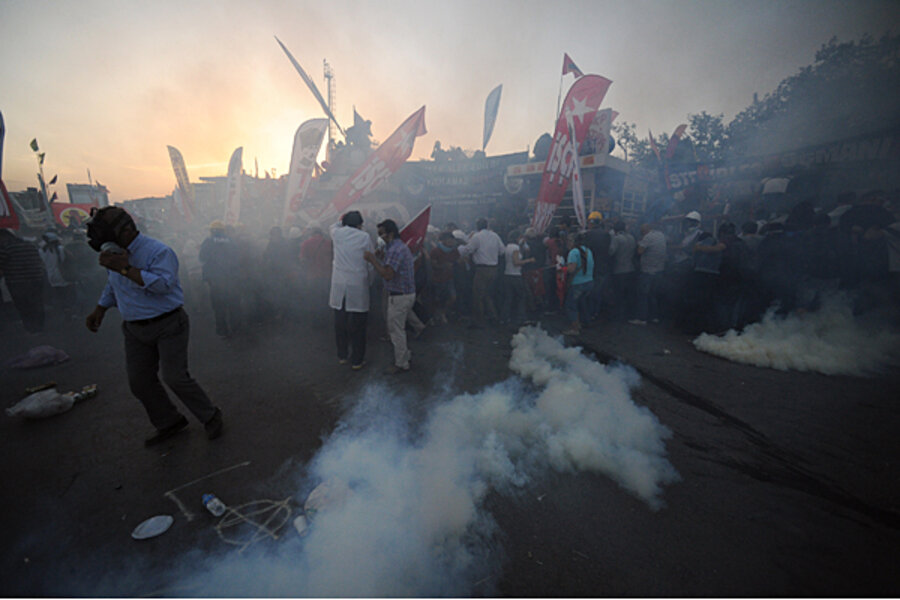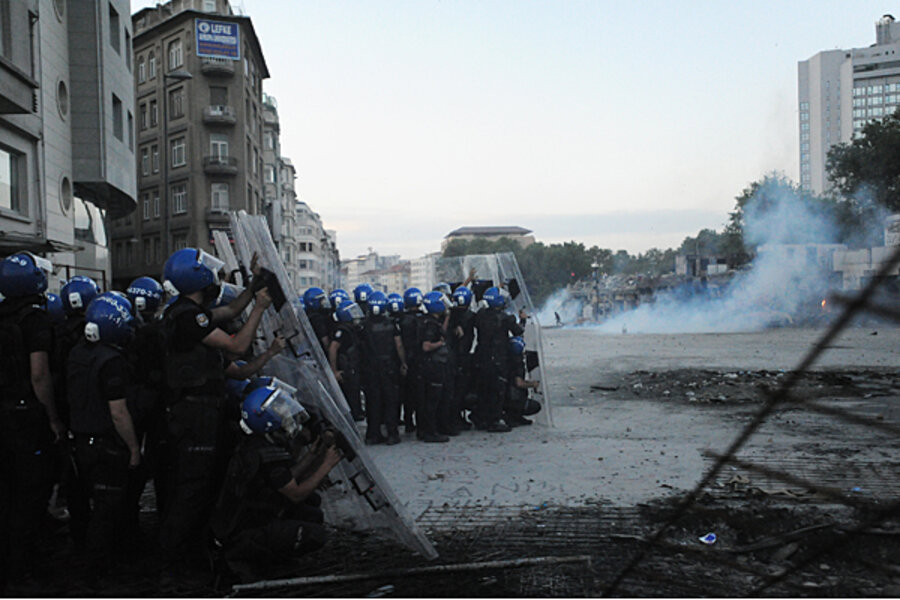Erdogan, protesters circle in eye of Taksim storm
| Istanbul
Demonstrators and police in Taksim Square have settled into an uneasy calm just hours after some of the most violent clashes since protests began two weeks ago. Riot control vehicles and police remained on the edges of the square, but it was quiet as demonstrators and municipal workers began the process of cleaning up. Dump trucks cleared away barricades built by demonstrators to keep the police out and protesters picked up trash and repitched tents knocked down during the night.
Now, each side is left guessing the other's next move, with neither giving ground. Although Prime Minister Recep Tayyip Erdogan has offered to to speak with protest leaders, those in Taksim say the talks are a farce. For the time being, Istanbul has the feeling of a city passing through the eye of a storm, rather than nearing its end.
Last week the square was the scene of celebrations, with opposition party flags hanging from building’s and the park’s statue. Thousands of people passed through the park each day, often singing, dancing, and chanting anti-government slogans.
Today, the day after police overran the square and Mr. Erdogan vowed not to tolerate any more protests, the mood among protesters had considerably dampened. Still, they vowed not to give up. In Taksim’s Gezi Park, where protests first began in response to plans to destroy the green space and build a commercial development, only several hundred people remained, although those still in the park say they expect more people will return in the evening when they finish work or school.
“One of the best things we learned is not to be scared of the government. This is something we gained that we’re not going to lose again even if we lose the park,” says Fulya Dagli, a demonstrator. “If they force us to go we’re not just going to go to our homes and not come back again. We’ll gather together and come back again.”
Before last night's clashes, police had withdrawn from Taksim, and the situation appeared to be quieting after Erdogan agreed to meet with protest leaders today. Many believed the police would hold off on any further action against the protesters at least until after the talks.
However, police stormed into Taksim early yesterday morning. Initially government officials said the police would leave protesters alone and only remove the banners they’d hung on public buildings, but the situation soon turned violent, with police firing tear gas and rubber bullets at demonstrators who hurled back stones, fireworks, and Molotov cocktails until almost 5 a.m.
Erdogan is still scheduled to meet with leaders of the protest movement today, but several of them have reportedly declined the invitation in response to last night’s clashes. It also remains unclear who exactly will meet with Erdogan, but distrustful protesters suspect the delegation of having close ties to the government.
“He said he would talk to some guys, but these people have nothing to do with us,” says Haldun Yildiz, a protester. Like many in Gezi Park, Mr. Yildiz says he doubts their bona fides as representatives for the protest movement, alleging they are just frivolous cultural figures. “It would be like Obama meets Kim Kardashian for the Occupy Wall Street movement.”
Erdogan’s unwillingness to compromise is now at the center of protesters’ grievances. They accuse the prime minister of behaving like an authoritarian, rather than the democratically elected leader he is – in the last election in 2011, Erdogan won 50 percent of the vote.
Since then he has pursued a number of controversial policies that have led those outside his support base to allege that he has done away with consensus building and only governs for the half of the country who elected him. Most recently Erodgan imposed restrictions on the marketing and sale of alcohol that many protesters say could be the first step toward removing more of their personal freedoms.
Wahit Kozacioglu, a protester, says he had been expecting a violent response from the government like he witnessed yesterday, but he remains uncertain what will happen moving forward.
“I don’t want to predict Erdogan’s actions, but he always uses violent methods. He is acting like an autocrat, not a prime minister,” he says.







